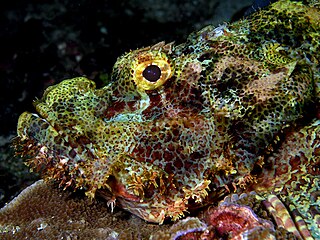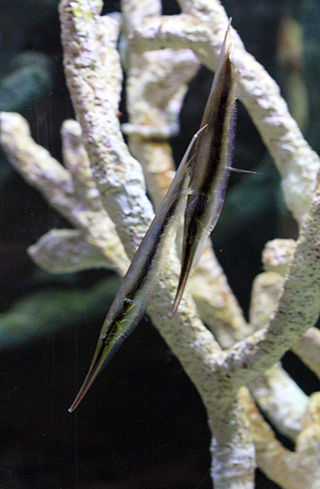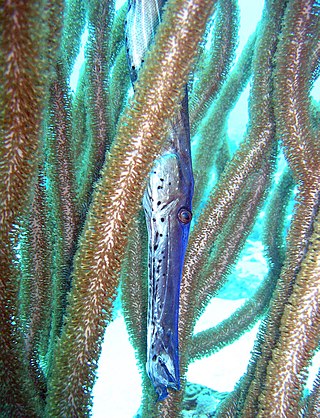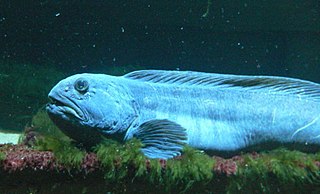
The Tetraodontiformes are an order of highly derived ray-finned fish, also called the Plectognathi. Sometimes these are classified as a suborder of the order Perciformes. The Tetraodontiformes are represented by 10 extant families and at least 349 species overall; most are marine and dwell in and around tropical coral reefs, but a few species are found in freshwater streams and estuaries. They have no close relatives, and descend from a line of coral-dwelling species that emerged around 80 million years ago.

The Scorpaeniformes are a diverse order of ray-finned fish, including the lionfishes and sculpins, but have also been called the Scleroparei. It is one of the five largest orders of bony fishes by number of species, with over 1,320.

Myliobatiformes is one of the four orders of batoids, cartilaginous fishes related to sharks. They were formerly included in the order Rajiformes, but more recent phylogenetic studies have shown the myliobatiforms to be a monophyletic group, and its more derived members evolved their highly flattened shapes independently of the skates.

The Scorpaenidae are a family of mostly marine fish that includes many of the world's most venomous species. As their name suggests, scorpionfish have a type of "sting" in the form of sharp spines coated with venomous mucus. The family is a large one, with hundreds of members. They are widespread in tropical and temperate seas but mostly found in the Indo-Pacific. They should not be confused with the cabezones, of the genus Scorpaenichthys, which belong to a separate, though related, family, Cottidae.

Cheilodactylidae, commonly called morwongs but also known as butterfish, fingerfins, jackassfish, sea carp, snappers, and moki, is a family of marine ray-finned fish. They are found in subtropical oceans in the Southern Hemisphere. The common name "morwong" is also used as a name for several unrelated fish found in Australian waters, such as the painted sweetlips. The classification of the species within the Cheilodactylidae and the related Latridae is unclear.

The Structural Classification of Proteins (SCOP) database is a largely manual classification of protein structural domains based on similarities of their structures and amino acid sequences. A motivation for this classification is to determine the evolutionary relationship between proteins. Proteins with the same shapes but having little sequence or functional similarity are placed in different superfamilies, and are assumed to have only a very distant common ancestor. Proteins having the same shape and some similarity of sequence and/or function are placed in "families", and are assumed to have a closer common ancestor.

Anoplopomatidae, the sablefishes, are a small family of ray-finned fishes classified within the order Scorpaeniformes. This family is the only family in the monotypic superfamily Anoplopomatoidea. These fishes are found in the North Pacific Ocean.

Rhamphocottidae is a family of ray-finned fishes belonging to the superfamily Cottoidea, the sculpins. The species in this family occur in the North Pacific Ocean.

Scorpaenoidei is a suborder of ray-finned fishes, part of the order Scorpaeniformes, that includes the scorpionfishes, lionfishes and velvetfishes. This suborder is at its most diverse in the Pacific and Indian Oceans but is also found in the Atlantic Ocean.

The Centriscidae are a family of fishes from the order Syngnathiformes which includes the snipefishes, shrimpfishes, and bellowfishes. A small family, consisting of only about a dozen marine species, they are of an unusual appearance, as reflected by their common names. The species in this family are restricted to relatively shallow, tropical parts of the Indo-Pacific.

Latridae commonly called trumpeters, is a family of marine ray-finned fish. They are found in temperate seas in the Southern Hemisphere. The classification of the species within the Latridae and the related Cheilodactylidae is unclear.They are fished commercially and for sport.

The Syngnathiformes are an order of ray-finned fishes that includes the trumpetfishes and seahorses.

Macroramphosus, snipefishes or bellowfishes, is a genus of fishes found in tropical and subtropical oceans at depths down to 600 metres (2,000 ft). According to FishBase, they are part of the family Centriscidae, but Nelson (2016) split that family, in which case the genus Macroramphosus is in the family Macroramphosidae. They have long second spines on their dorsal fins and tiny mouths at the tip of their greatly elongated snouts. The bodies of snipefish are more streamlined than in the related bellowfishes. They reach a maximum length of about 20 cm (7.9 in), and are silvery or reddish in colour. They are sometimes found in large schools. This is the only genus on the monogeneric family Macroranphosidae but some authorities include the genera Centriscops and Notopogon in this family too.

The bellowfishes or bellowsfishes are fishes in the genus Notopogon in the family Centriscidae. They are found in deeper parts of the temperate southern oceans, although the longspine bellowfish has been recorded as far north as New Caledonia and Madagascar. According to FishBase, they are part of the family Centriscidae, but some authorities split that family, in which case the genus Notopogon is in the family Macroramphosidae, which is followed here. They have long second spines on their dorsal fins and tiny mouths at the tip of their greatly elongated snouts. Their bodies are relatively high, unlike the related snipefishes. They reach a maximum length of about 34 cm (13 in), and are silvery or reddish in colour.

Zoarcoidei is a suborder of marine ray-finned fishes belonging to the order Scorpaeniformes. The suborder includes the wolffishes, gunnels and eelpouts. The suborder includes about 400 species. These fishes predominantly found in the boreal seas of the northern hemisphere but they have colonised the southern hemisphere.

The Gobiiformes are an order of fish that includes the gobies and their relatives. The order, which was previously considered a suborder of Perciformes, is made up of about 2,211 species that are divided between seven families. Phylogenetic relationships of the Gobiiformes have been elucidated using molecular data. Gobiiforms are primarily small species that live in marine water, but roughly 10% of these species inhabit fresh water. This order is composed chiefly of benthic or burrowing species; like many other benthic fishes, most gobiiforms do not have a gas bladder or any other means of controlling their buoyancy in water, so they must spend most of their time on or near the bottom. Gobiiformes means "Goby-like".

Macroramphosidae, the snipefishes and bellowsfishes is a family of oviparous, marine fish which form part of the superfamily Centriscoidea, which is one of the two superfamilies in the suborder Aulostomoidei of the order Syngnathiformes, which includes the seahorses, pipefishes, trumpetfishes and dragonets. It has been considered to be a subfamily of the Centriscidae but Nelson (2016) classified it as a family.

Cottoidei is a suborder of ray-finned fishes which, according to the 5th edition of Fishes of the World, is placed within the order Scorpaeniformes, alongside the scorpionfishes, flatheads, eelpouts, sticklebacks and related fishes.

Aulostomoidei is a suborder of the order Syngnathiformes, which also contains groups such as the seahorses, pipefishes and dragonets.

Ovalentaria is a clade of ray-finned fishes within the Percomorpha, referred to as a subseries. It is made up of a group of fish families which are referred to in Fishes of the World's fifth edition as incertae sedis, as well as the orders Mugiliformes, Cichliformes, and Blenniiformes. It was named by W. L. Smith and T. J. Near in Wainwright et al. (2012) based on a molecular phylogeny, but the authors suggested that the group was united by the presence of demersal eggs that are attached to a substrate. Some authors have used the ordinal name Stiassnyiformes for a clade including Mugiloidei, Plesiopidae, Blenniiformes, Atherinomorpha, and Cichlidae, and this grouping does appear to be monophyletic.






















